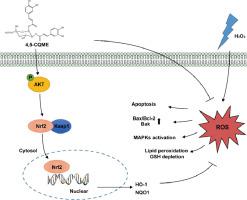当前位置:
X-MOL 学术
›
Phytomedicine
›
论文详情
Our official English website, www.x-mol.net, welcomes your
feedback! (Note: you will need to create a separate account there.)
4,5-di-O-caffeoylquinic acid methyl ester isolated from Lonicera japonica Thunb. targets the Keap1/Nrf2 pathway to attenuate H2O2-induced liver oxidative damage in HepG2 cells.
Phytomedicine ( IF 6.7 ) Pub Date : 2020-04-23 , DOI: 10.1016/j.phymed.2020.153219 Lingyun Xiao 1 , Shu Liang 2 , Lanlan Ge 1 , Haoqiang Wan 3 , Weigang Wu 2 , Jia Fei 4 , Shipin Wu 2 , Boping Zhou 2 , Xiaobin Zeng 5
Phytomedicine ( IF 6.7 ) Pub Date : 2020-04-23 , DOI: 10.1016/j.phymed.2020.153219 Lingyun Xiao 1 , Shu Liang 2 , Lanlan Ge 1 , Haoqiang Wan 3 , Weigang Wu 2 , Jia Fei 4 , Shipin Wu 2 , Boping Zhou 2 , Xiaobin Zeng 5
Affiliation

|
BACKGROUND
4,5-di-O-caffeoylquinic acid methyl ester (4,5-CQME) is a caffeoylquinic acid (CQA) isolated from Lonicera japonica Thunb., a traditional Chinese medicine. To date, the biological activity of 4,5-CQME has not been fully investigated.
PURPOSE
The aim of the current study was to explore the anti-oxidative activity and the underlying mechanism of 4,5-CQME.
METHODS
MTT assay was used to evaluate the cytoprotective effect of 4,5-CQME. DCFH-DA was used as a fluorescence probe to detect intracellular ROS. The mitochondrial membrane potential was detected using the fluorescent probe JC-1. MDA and GSH levels were measured using MDA and GSH commercial kits, respectively. Apoptosis assay was performed using the Annexin V-FITC/PI method. The functional mechanism of 4,5-CQME was investigated by analyzing relative signaling pathways through immunofluorescent staining, quantitative PCR and western blot analysis.
RESULTS
HepG2 cells were incubated with different concentrations of 4,5-CQME for 12 h before exposure to 500 μM H2O2 for 3 h. 4,5-CQME attenuated H2O2-induced oxidative damage and had a higher cytoprotective effect than 3-caffeoylquinic acid, 3-caffeoylquinic acid methyl ester, or 4,5-di-O-caffeoylquinic acid. 4,5-CQME also reduced ROS and MDA levels and rescued GSH depletion. Western blots demonstrated that 4,5-CQME decreased Bax/Bcl-2 and Bak levels. A mechanistic study confirmed that 4,5-CQME significantly suppressed H2O2-induced MAPKs phosphorylation but had little effect on MAPKs phosphorylation under normal conditions. By contrast, 4,5-CQME induced AKT phosphorylation in the presence or absence of H2O2. 4,5-CQME also regulated the Keap1/Nrf2 signaling pathway and enhanced both the mRNA and protein expressions of HO-1 and NQO1. The anti-oxidative effect of 4,5-CQME was greatly abolished by co-incubation with the Nrf2 inhibitor ML385 or PI3K inhibitor wortmannin.
CONCLUSIONS
Taken together, these results showed that 4,5-CQME offered significant protection against H2O2-induced oxidative stress, and its effect was in part due to the modulation of the Keap1/Nrf2 pathway.
中文翻译:

从 Lonicera japonica Thunb 中分离出 4,5-二-O-咖啡酰奎尼酸甲酯。靶向 Keap1/Nrf2 通路,减轻 H2O2 诱导的 HepG2 细胞肝脏氧化损伤。
背景技术4,5-二-O-咖啡酰奎尼酸甲酯(4,5-CQME)是从中药忍冬中分离得到的咖啡酰奎尼酸(CQA)。迄今为止,4,5-CQME 的生物活性尚未得到充分研究。目的本研究的目的是探索4,5-CQME的抗氧化活性及其潜在机制。方法采用MTT法评价4,5-CQME的细胞保护作用。 DCFH-DA用作荧光探针来检测细胞内ROS。使用荧光探针JC-1检测线粒体膜电位。 MDA 和 GSH 水平分别使用 MDA 和 GSH 商业试剂盒测量。使用Annexin V-FITC/PI方法进行细胞凋亡测定。通过免疫荧光染色、定量PCR和蛋白质印迹分析相关信号通路来研究4,5-CQME的功能机制。结果 HepG2 细胞与不同浓度的 4,5-CQME 孵育 12 小时,然后暴露于 500 μM H2O2 3 小时。 4,5-CQME 可减轻 H2O2 诱导的氧化损伤,并且比 3-咖啡酰奎尼酸、3-咖啡酰奎尼酸甲酯或 4,5-二-O-咖啡酰奎尼酸具有更高的细胞保护作用。 4,5-CQME 还可以降低 ROS 和 MDA 水平并挽救 GSH 消耗。蛋白质印迹表明 4,5-CQME 降低 Bax/Bcl-2 和 Bak 水平。机制研究证实,4,5-CQME 显着抑制 H2O2 诱导的 MAPKs 磷酸化,但在正常条件下对 MAPKs 磷酸化影响不大。相比之下,无论有或没有 H2O2,4,5-CQME 都会诱导 AKT 磷酸化。 4,5-CQME 还调节 Keap1/Nrf2 信号通路并增强 HO-1 和 NQO1 的 mRNA 和蛋白表达。 4,5-CQME 的抗氧化作用通过与 Nrf2 抑制剂 ML385 或 PI3K 抑制剂渥曼青霉素共孵育而被大大消除。结论 综上所述,这些结果表明 4,5-CQME 对 H2O2 诱导的氧化应激具有显着的保护作用,其作用部分归因于 Keap1/Nrf2 通路的调节。
更新日期:2020-04-23
中文翻译:

从 Lonicera japonica Thunb 中分离出 4,5-二-O-咖啡酰奎尼酸甲酯。靶向 Keap1/Nrf2 通路,减轻 H2O2 诱导的 HepG2 细胞肝脏氧化损伤。
背景技术4,5-二-O-咖啡酰奎尼酸甲酯(4,5-CQME)是从中药忍冬中分离得到的咖啡酰奎尼酸(CQA)。迄今为止,4,5-CQME 的生物活性尚未得到充分研究。目的本研究的目的是探索4,5-CQME的抗氧化活性及其潜在机制。方法采用MTT法评价4,5-CQME的细胞保护作用。 DCFH-DA用作荧光探针来检测细胞内ROS。使用荧光探针JC-1检测线粒体膜电位。 MDA 和 GSH 水平分别使用 MDA 和 GSH 商业试剂盒测量。使用Annexin V-FITC/PI方法进行细胞凋亡测定。通过免疫荧光染色、定量PCR和蛋白质印迹分析相关信号通路来研究4,5-CQME的功能机制。结果 HepG2 细胞与不同浓度的 4,5-CQME 孵育 12 小时,然后暴露于 500 μM H2O2 3 小时。 4,5-CQME 可减轻 H2O2 诱导的氧化损伤,并且比 3-咖啡酰奎尼酸、3-咖啡酰奎尼酸甲酯或 4,5-二-O-咖啡酰奎尼酸具有更高的细胞保护作用。 4,5-CQME 还可以降低 ROS 和 MDA 水平并挽救 GSH 消耗。蛋白质印迹表明 4,5-CQME 降低 Bax/Bcl-2 和 Bak 水平。机制研究证实,4,5-CQME 显着抑制 H2O2 诱导的 MAPKs 磷酸化,但在正常条件下对 MAPKs 磷酸化影响不大。相比之下,无论有或没有 H2O2,4,5-CQME 都会诱导 AKT 磷酸化。 4,5-CQME 还调节 Keap1/Nrf2 信号通路并增强 HO-1 和 NQO1 的 mRNA 和蛋白表达。 4,5-CQME 的抗氧化作用通过与 Nrf2 抑制剂 ML385 或 PI3K 抑制剂渥曼青霉素共孵育而被大大消除。结论 综上所述,这些结果表明 4,5-CQME 对 H2O2 诱导的氧化应激具有显着的保护作用,其作用部分归因于 Keap1/Nrf2 通路的调节。































 京公网安备 11010802027423号
京公网安备 11010802027423号